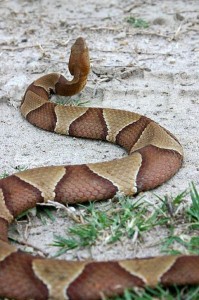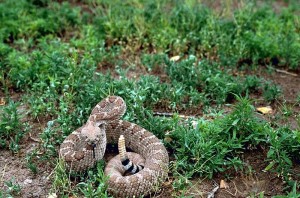In North America there are two main types of venomous snakes: the crotalids and the elapids. The crotalids are also known as pit vipers because of the heat sensing organ within the hole or “pit” on the front of the snake’s head. Examples of snakes from this group are the rattlesnake, the copperhead and the cottonmouth or water moccasin.
The venom of the crotalids is injected through the fang of the viper. This venom is a mix of enzymes. These enzymes cause damage throughout the body and can cause the tissue to die. They break down the red blood cells. Some snakes from the crotalids can inflict some form of paralysis.
Some pit viper bites may not contain any venom at all. This is somewhat rare, and effects of an envenoming bite may show up for several hours. So if you are bitten and do not show any immediate effects, the best thing to do is go to the nearest hospital anyway. Do not assume the bite was a “dry bite.”
Symptoms that are typical of pit viper bites include dizziness, weakness, tremors, low blood pressure, and altered consciousness.
If you are bitten by a pit viper, seek medical attention immediately. DO NOT cut and suck or perform other “home remedies.” Some physicians recommend a light constriction (NOT a tourniquet). If you do apply a constrictor band, be sure a pulse can be felt below the band.
The only truly effective treatment for these bites is anti venom.
The only elapid in North America is the coral snake. Coral snakes are easily identified by the “red on yellow kill a fellow” bands. These venom snakes is a neurotoxin. It will affect the nervous system of the victim.
Coral snakes take longer to inject their venom than the pit vipers, but as with pit viper bites, seek medical help immediately.
Video from SurvivalMedicine


